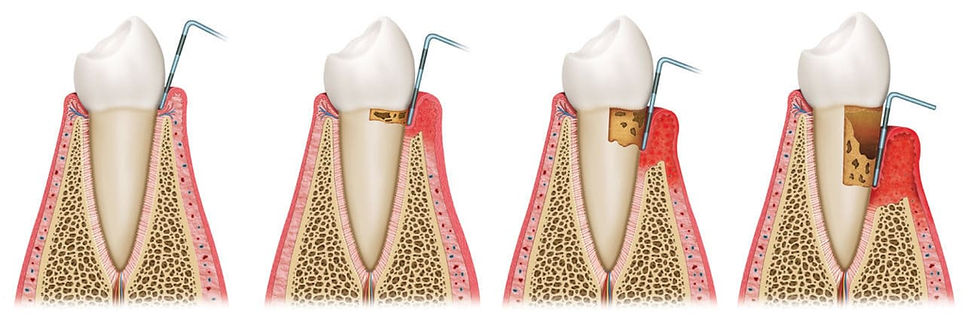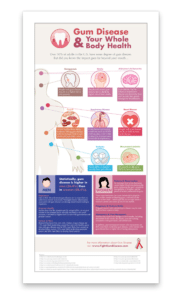Periodontal Disease: Symptoms, Stages, and Effective Gum Disease Treatment in NYC
- BrightSmileDesign
- Jul 18
- 3 min read
Protect Your Smile from the Leading Cause of Tooth Loss
At Bright Smile Design Dental, we take your gum health seriously. Periodontal disease, commonly known as gum disease, is a progressive infection of the gums and bone that support your teeth. It can start silently and painlessly but eventually lead to tooth loss and serious health complications if left untreated.
Led by Dr. Alexander Lezhansky, DDS, FICOI, our expert team offers advanced, personalized care to treat all stages of periodontal disease and restore your oral health.

What Is Periodontal Disease?
Periodontal disease is an inflammatory condition that affects the soft tissue and bone surrounding your teeth. It's typically caused by plaque and tartar buildup due to poor oral hygiene, but genetics, health conditions, and lifestyle habits can also increase your risk.
The disease progresses in four stages:
Gingivitis – Reversible inflammation of the gums
Mild Periodontitis – Early bone loss begins
Moderate Periodontitis – Tissue destruction, infection, and gum recession occur
Advanced Periodontitis – Severe bone loss and tooth mobility; potential tooth loss
Common Symptoms of Gum Disease
Recognizing early signs is crucial. Symptoms of periodontal disease include:
Swollen, red, or bleeding gums
Persistent bad breath (halitosis)
Gum recession and tooth sensitivity
Loose or shifting teeth
Pus or pain near the gum line
Changes in bite or how teeth fit together
If you experience any of these symptoms, schedule an evaluation with Dr. Lezhansky—early intervention can prevent permanent damage.
Causes and Risk Factors
The most common cause of periodontal disease is bacterial plaque that hardens into tartar. However, certain risk factors can accelerate the condition:
Smoking or tobacco use
Poor brushing and flossing habits
Diabetes and autoimmune conditions
Hormonal changes (pregnancy, menopause)
Genetics or family history
High stress levels
Heart disease or poor circulation
While gum disease isn’t directly contagious, the bacteria responsible for it can be spread through saliva.
How We Diagnose Gum Disease at Bright Smile Design
During your comprehensive periodontal exam, Dr. Alexander Lezhansky will:
Measure gum pocket depth using a periodontal probe
Assess tooth mobility and gum recession
Review X-rays to identify bone loss
Evaluate your bite alignment and plaque levels
These tools help us determine the exact stage of gum disease and recommend a treatment plan tailored to your condition and overall health.
At Bright Smile Design Dental, we use state-of-the-art treatments to manage and reverse gum disease when possible. Your treatment depends on the stage of the disease and your overall dental health.
1. Professional Dental Cleaning & Oral Hygiene Guidance
Ideal for early-stage gingivitis
Removes plaque and tartar above the gumline
Emphasizes brushing, flossing, and antibacterial rinses
2. Scaling and Root Planing (Deep Cleaning)
Recommended for mild to moderate periodontitis
Removes plaque and bacteria below the gumline
Smooths root surfaces to prevent bacterial reattachment
Minimally invasive treatment using dental lasers
Targets and removes diseased tissue while preserving healthy gums
Faster healing with minimal discomfort
4. Pocket Reduction Surgery
Surgical flap procedure to access deep plaque
Removes infection and reshapes bone
Often combined with bone grafting or tissue regeneration
5. Bone Grafting & Guided Tissue Regeneration (GTR)
Rebuilds bone and supports tissue regrowth
Uses graft material and membranes to promote healing
Ideal for patients with significant bone loss
6. Gum Grafting
Covers exposed roots and reinforces gum tissue
Improves smile aesthetics and reduces sensitivity
7. Platelet-Rich Fibrin (PRF) Therapy
Uses your own blood to accelerate healing
Reduces recovery time and improves surgical outcomes

Is Gum Disease Curable?
Gingivitis, the earliest stage, is completely reversible with professional cleanings and proper home care. However, advanced periodontitis is not curable, but it is manageable. With the right treatment plan and regular maintenance, patients can maintain their teeth and prevent further damage.
Why Treat Gum Disease?
Untreated periodontal disease can lead to more than just tooth loss. Research shows a strong link between gum disease and systemic health issues like:
Heart disease and stroke
Diabetes complications
Respiratory infections
Adverse pregnancy outcomes
By managing gum disease, you’re not just protecting your smile—you’re safeguarding your overall health.
Prevention: How to Protect Your Gums
You can reduce your risk of gum disease by:
Brushing 2–3 times daily with fluoride toothpaste
Flossing at least once a day
Using antibacterial mouthwash
Avoiding tobacco products
Managing chronic health conditions
Visiting Bright Smile Design every 6 months
Some patients may benefit from more frequent periodontal cleanings to prevent recurrence.
When to See a Periodontal Specialist in NYC
If you’re noticing bleeding gums, persistent bad breath, or gum recession, don’t wait. The earlier you seek treatment, the more we can do to preserve your natural teeth.
Schedule your consultation today with Dr. Alexander Lezhansky, DDS, FICOI, and get personalized, expert care from one of NYC’s top periodontal specialists.







Comments